
The Darling Downs is a farming region on the western slopes of the Great Dividing Range in southern Queensland, Australia. The Downs are to the west of South East Queensland and are one of the major regions of Queensland. The name was generally applied to an area approximating to that of the Condamine River catchment upstream of Condamine township but is now applied to a wider region comprising the Southern Downs, Western Downs, Toowoomba and Goondiwindi local authority areas. The name Darling Downs was given in 1827 by Allan Cunningham, the first European explorer to reach the area and recognises the then Governor of New South Wales, Ralph Darling.
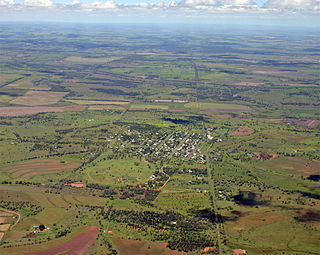
Bell is a rural town and locality in the Western Downs Region, Queensland, Australia. It is in the western foothills of the Bunya Mountains, 39 kilometres (24 mi) north of Dalby. At the 2016 census, Bell had a population of 502.

Canning Downs was the first residential establishment built by a white person on the Darling Downs in Queensland, Australia. It is located a short drive from the town of Warwick and originally extended south east to Killarney and the McPherson Range. The area was first named after the British statesman George Canning by Allan Cunningham.

Jimbour is a town in the locality of Jimbour East, Western Downs Region, Queensland, Australia.
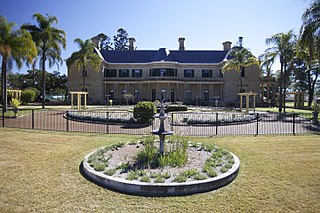
Jimbour is a heritage-listed homestead on one of the earliest stations established on the Darling Downs, Queensland, Australia, It is important in demonstrating the pattern of early European exploration and pastoral settlement in Queensland, Australia. The building is associated with the development of the Darling Downs and of the pastoral industry in Queensland and is important in demonstrating the wealth and ambition of early Queensland pastoralists.
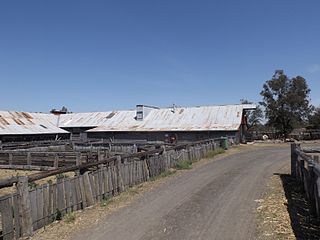
Jondaryan Woolshed is a heritage-listed shearing shed at Evanslea Road, Jondaryan, Queensland, Australia. It was built in 1859-60 to replace an earlier, smaller woolshed on the former Jondaryan pastoral station, which was at one stage the largest freehold station in Queensland. The woolshed was the scene of significant labour conflict in the late 1880s and early 1890s, as the station became a test case for the new Queensland Shearers Union in the lead-up to the 1891 Australian shearers' strike.
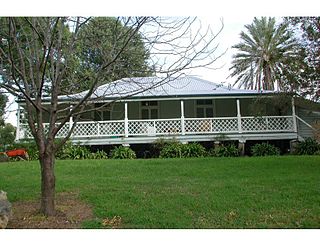
Jondaryan Homestead is a heritage-listed homestead at Evanslea Road, Jondaryan, Toowoomba Region, Queensland, Australia. It was the base of the former Jondaryan pastoral station, which was originally taken up in 1840, and at one time was the largest freehold station in Queensland. The site contains the current house, which was built after the original was destroyed by fire in 1937, the original kitchen dating from 1844, and a kitchen, butcher's shop, shearer's quarters, stables, dairy, toilet block and store, many dating from the 1860s. It also contains the remains of horse stalls, a slaughterhouse, hide store, and Chinese gardener's glasshouse. It was added to the Queensland Heritage Register on 21 October 1992.

Fassifern Homestead is a heritage-listed homestead at 1008B Boonah-Fassifern Road, Kalbar, Scenic Rim Region, Queensland, Australia. It was built circa 1880. It was added to the Queensland Heritage Register on 13 November 2008.
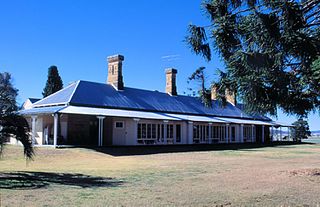
Talgai Homestead is a heritage-listed homestead at Allora, Southern Downs Region, Queensland, Australia. It was designed by architect Richard George Suter for Queensland pastoralist and politician George Clark and was built in 1868. It was added to the Queensland Heritage Register on 21 August 1992. It is also known as East Talgai Homestead to distinguish it from the West Talgai Homestead built by Clark's brother, Charles Clark.

Ballandean Homestead is a heritage-listed homestead at Ballandean, Southern Downs Region, Queensland, Australia. It was built from c. 1840 to 1890s circa. It was added to the Queensland Heritage Register on 21 October 1992.

Glengallan Homestead is a heritage-listed homestead on the New England Highway, Glengallan, Southern Downs Region, Queensland, Australia. It was built from 1864 to 1904. It is also known as Glengallan Head Station. It was added to the Queensland Heritage Register on 21 October 1992 and is open to the public.

Stonehouse is a heritage-listed former homestead and inn on the D'Aguilar Highway, Moore, Somerset Region, Queensland, Australia. It was built from c. 1874 to 1888. It was added to the Queensland Heritage Register on 25 October 2002.

Burrandowan Station Homestead is a heritage-listed homestead at Kingaroy Road, Durong, South Burnett Region, Queensland, Australia. It was built from 1848 to c. 1927. It was added to the Queensland Heritage Register on 21 October 1992.

Old Rainworth Stone Store is a heritage-listed storehouse and now museum at Wealwandangie Road, Cairdbeign, 10 kilometres (6.2 mi) south of the town of Springsure, Central Highlands Region, Queensland, Australia. It was built in 1862 by George Goldring. It is also known as Old Rainworth Fort and Rainworth Head Station Store. It was added to the Queensland Heritage Register on 21 October 1992.

The Glebe Homestead is a heritage-listed homestead at Taroom-Cracow Road, Glebe near Taroom, Shire of Banana, Queensland, Australia. It was designed by Florence Mary Rigby and built c. 1920. It is also known as Broadwater. It was added to the Queensland Heritage Register on 23 March 2007.

Taromeo Station is a pastoral farm off the D'Aguilar Highway, Benarkin, South Burnett Region, Queensland, Australia. It was built from 1854 to the 1860s. It is also contains the Taromeo cemetery. The Taromeo Homestead and its cemetery were added to the Queensland Heritage Register on 21 October 1992.

Boondooma Homestead is a heritage-listed homestead at Mundubbera - Durong Road, Boondooma, South Burnett Region, Queensland, Australia. It was built from the 1850s to the 1870s. It was added to the Queensland Heritage Register on 21 October 1992.
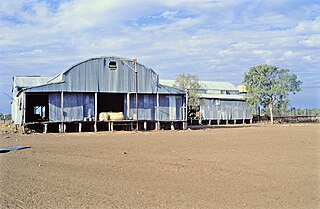
Darr River Downs is a heritage-listed homestead at Landsborough Highway, Morella, Longreach Region, Queensland, Australia. It was built from 1870s circa to 1900s circa. It was added to the Queensland Heritage Register on 27 June 2003.

Jimbour East is a locality in the Western Downs Region, Queensland, Australia. In the 2006 census, Jimbour East had a population of 185 people.

Jimbour West is a locality in the Western Downs Region, Queensland, Australia. In the 2016 census, Jimbour West had a population of 56 people.




















